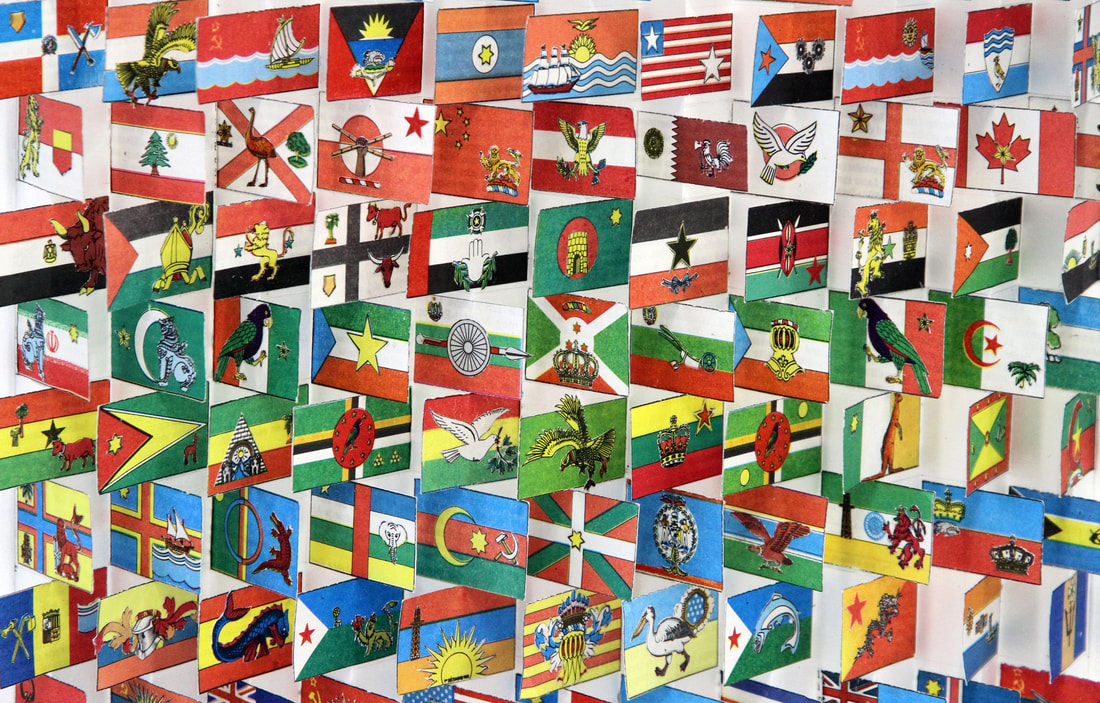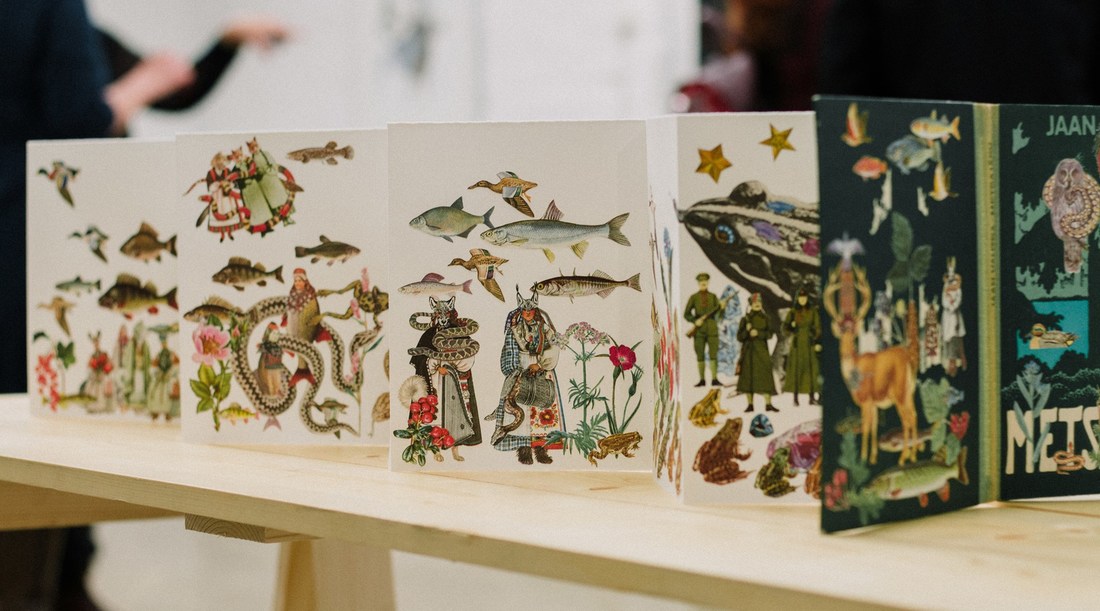Stories in the making |
|
This unconventional binding structure is known as a flag book, and the content itself is also comprised of flags as well as motifs from coats of arms. Every flag has been modified through the addition of a motif from another flag while the coats of arms have been reconfigured into new forms and alliances. The work challenges the notion of inviolable national symbols and cultural identities, instead acknowledging that every nation and culture has evolved over time from multiple generations of migrations and hybrid cultural influences. The vintage collage material was sourced from redundant Estonian encyclopaedias during an artist residency at the Estonian Printing and Paper Museum, Tartu, in 2017. It is fitting that a number of the flags themselves are now redundant following the dissolution of the Soviet Union.
Video animation by Oliver Clifton, X-ray Vision, of scanned pages of The Trees Mourn with the Serpent Queen The book is based on the Lithuanian legend of Eglė (Spruce), a young woman who catches the eye and the heart of the Serpent King. She reluctantly agrees to marry him. Her family do not wish her to go and try to fool the serpents by dressing first a goose, then a sheep, then a cow in her wedding dress, but each time a cuckoo alerts the serpents to the deception. The marriage finally takes place and Eglė goes to live with the Serpent King beneath the ocean, discovering that he is, in fact, a handsome youth with a grand palace. When, many years later, she returns to visit her father’s home with her own children, Eglė’s brothers take their scythes and slay the Serpent King and all the snakes. Heartbroken, Eglė transforms herself and her children into trees.
The form of the book is based on vetrungės, decorative weathervanes specific to the coastal regions of Lithuania. Vetrungės featured on traditional sailing boats and served to identify individual owners, often including motifs specific to individual histories. Video animation by Oliver Clifton, X-ray Vision, of scanned pages of Trans Baltic-Tasman Crossing This Coptic stitch book is an ode to my ancestral roots in the Baltics and the hold the region still has on my cultural and emotional identity. The work taps into the mythology surrounding the lure of ocean voyages to allude to refugee migrations from the Baltics to the Antipodes in the wake of WWII, that also often entailed an uncertain journey from the known to the unknown. The vintage collage material was sourced during an artist residency at the Estonian Printing and Paper Museum, Tartu, in 2017, and has been supplemented with used business envelopes from my letter box, bridging Australian and Baltic motifs and references.
This book references an episode within the Estonian epic poem Kalevipõeg, in which the beautiful human girl Salme marries the Prince of the Stars, and leaves her earthly home to live with him amongst the clouds. Salme was hatched from a grouse egg, while her sister, Linda, began life as a hen and a third girl, their servant, had originally been a raven. In the tale, Salme refuses marriage proposals from both the Sun and the Moon, before agreeing to take the Prince of the Stars as her husband. Each of her suitors arrive with a retinue of 60 horses. The vintage collage material was sourced during an artist residency at the Estonian Printing and Paper Museum, Tartu, in 2017, and has been supplemented with used business envelopes. The three-tier concertina structure can be displayed in a circle, and is commonly referred to as a star book.
This tunnel book is an ode to my ancestral roots in the Baltics and the hold the region still has on my cultural and emotional identity. The work taps into an underlying longing to ‘return’ to the motherland, despite being born and growing up in Australia, by harnessing the mythology surrounding sirens and the lure of ocean voyages. The vintage collage material was sourced during an artist residency at the Estonian Printing and Paper Museum, Tartu, in 2017, and has been supplemented with used business envelopes from my letter box, bridging Australian and Baltic motifs and references. The images above show individual layers from the book.
The Slippery She-Wolf Dreams in Snakish was created in Estonia while Tartu Artist in Residence, utilising collage elements sourced from the Estonian Printing & Paper Museum, 2017. The book is my response to female werewolf lore and folklore that I encountered in the course of the residency, including Andrus Kivirähk's fabulous novel, The Man Who Spoke Snakish.
Video animation by Oliver Clifton, X-ray Vision, of scanned pages of Stoat The vintage book cover and collage material were sourced during an artist residency at the Estonian Printing and Paper Museum, Tartu, in 2017. The book cover had already been emptied of its contents, so I imagined new contents based simply on the cover imagery. (Kärp means Stoat in Estonian). I was struck by the visual correspondences between the hills on the cover illustration and the curving back of a mink illustration in a redundant Estonian natural history book, and conceived a narrative in which the stoat was both the subject and the context of the book. The resulting imagery comprises a landscape formed by stoats and similar animals, inhabited by progressively smaller stoats and similar animals.
This stab bound book makes use of milk cartons collected in the course of an artist residency at the Estonian Printing and Paper Museum, Tartu, in 2017, as well as a subsequent visit in 2018. This particular brand of milk featured the slogan “Thank you for loving Estonian milk” (Aitäh, et armastad Eesti piima). The design is loosely based on traditional Baltic jewellery. In being transformed into a ‘necklace’, the cartons themselves have been reimagined as a clichéd token of love.
4 degrees of love in the Baltics was created from Farmi and Rokiškis milk cartons collected over the course of a three months in Estonia while Tartu Artist in Residence. Decorative motifs were cut from the cartons and arranged to suggest Baltic jewellery uncovered in archaeological digs, before being stitched into place on their paper panels.
|
books in progress & artist statementsFind out the stories behind the books including selected documentation of books in progress Archives
February 2023
Categories |





 RSS Feed
RSS Feed